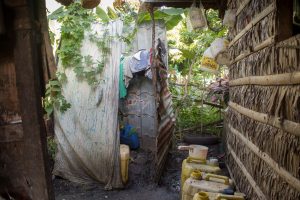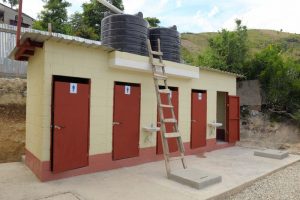Why we need to make a big deal about toilets
Others, Child Poverty , HealthContributed by: Compassion Canada
Learn about the global sanitation crisis and why we are putting toilet talk on the agenda.
Written by: Rebekah Malbrecht
There is something in your home that contributes to keeping you healthy more than you would ever give it credit for. What is that life-saving item? Your toilet. Though many of us wouldn’t have our toilet listed at the top of our daily gratitude list, it is something that is absolutely a critical part of our daily life.
While we may not pause to think of the impact of our toilets until something goes wrong and we need to fix it, most of the world thinks about it daily. The impact of sanitation facilities is quite literally life or death.

Compassion has always actively engaged in these concerns through our Water, Sanitation and Hygiene (WaSH) initiatives. For many people, clean water can be understood as the most critical need when it comes to WaSH issues, but today we want to invite you in on the vital importance of sanitation facilities and the incredible impact they can have on children, their families and their communities.
We are answering five questions about WaSH to help you understand the importance of safe sanitation facilities!

Q: Compassion has initiatives for water, sanitation and hygiene. Which is the most crucial need to address?
A: This is a bit of a trick question because water, sanitation and hygiene are all extremely important for those living in poverty! But it does give us an opportunity to talk about how these three things are interrelated. Most of us know just how important access to clean water is because all of us need water to live. Water is an essential resource. And after living the global reality of COVID-19, we don’t need to tell you just how important hygiene is. Access to basic hygiene such as handwashing stations saves lives.
But here is where sanitation comes in. The is world facing a sanitation crisis with 4.2 billion people lacking safely managed sanitation services and 2.4 billion people who do not even have basic sanitation (UN). This crisis directly impacts their sources of clean water and hygiene because poorly managed waste pollutes water sources, soil and perpetuates hygiene issues.
So, this means that although water, sanitation and hygiene are all important and crucial needs, addressing the sanitation crisis for those in poverty can have far reaching impact that solves more than one problem.

A makeshift toilet behind a home in the Philippines.
Q: What is the global sanitation crisis?
A: The sanitation crisis is, in its simplest terms, the lack of access to safely managed sanitation facilities for the majority of the global population. In our world today, 3 in 10 people lack access to clean water for drinking but 6 in 10 people lack access to safely managed sanitation facilities (UN). When more than half of the world is lacking this resource, it is safe to say that we need to take it seriously.
Toilets are essential to keep people healthy. In fact, poor sanitation is linked to transmission of all sorts of diseases such as cholera, diarrhea, dysentery, hepatitis A and typhoid, just to name a few (WHO). Nearly 1,000 children die every day due to diarrheal diseases alone as a result of polluted water and inadequate sanitation.

Even for those who do have access to basic sanitation, many of these facilities and services are vulnerable and weak. Severe storms, flooding, drought or other natural disasters can damage sanitation systems and spread raw sewage. This can create public health crises for those who are already vulnerable.
It is the most vulnerable in the world who are most affected. Poverty drains the hope of children, their families and entire communities as they bear the brunt of impact in this crisis. Sanitation is a human right. This means the sanitation crisis is a human rights crisis that we need to step up and take action in to restore hope and dignity to those who need it most.

Q: If someone doesn’t have a toilet, then what?
A: For those who don’t have access to a toilet or sanitation facilities, often their only option is to make do with what resources they have. Local water sources like streams and rivers or open bodies of water become a primary solution for many. Some will attempt to manage this problem through compost toilets in which waste is stored underground. But for at least 892 million people, open defecation is still the primary practice (UN).

With a lack of washrooms, streams like this become a space for communities to relieve themselves while also serving as a space to wash clothes and dishes.
All of these solutions present problems. Local sources of water are polluted with waste, underground waste storage contaminates the soil and can run into water sources such as local wells. Open defecation has the most severe impact, causing the highest number of deaths for children under 5 years where this practice is widespread. Countries where open defecation is most common are also those with the highest levels of malnutrition and poverty (WHO).
When the resources you do have need to be allocated towards food for your family to survive, a toilet often takes a backseat. Unfortunately, the alternatives only perpetuate the sanitation crisis and for many families and their communities, there seems to be no hope in sight.

Q: Who is most affected by the sanitation crisis?
A: Understanding more about the global sanitation crisis, we have come to see that it is the most vulnerable in the world who are most affected. This means those who live in poverty, and more specifically, children and Every year, 297,000 children are estimated to die as a direct result of diseases caused by unsafe water, sanitation and hygiene (UN). This is a tragic reality.
For women and girls, the sanitation crisis impacts them in more ways than one. Not only are they at risk for the diseases that inadequate sanitation causes, they also are at higher risk of abuse and violence and are vulnerable due to lack of privacy. A toilet is an instrument of dignity for women and girls around the world and quality sanitation facilities provide security and protection.

On top of disease-prevention, dignity and protection, toilets help women and girls navigate the realities of menstruation. Globally, at least 500 million women and girls lack the adequate facilities for menstrual hygiene management (World Bank). This causes girls to have to miss school during their periods, impacting their education and opportunities. About half of schools in low-income countries lack proper sanitation facilities crucial for students and teachers to manage their periods (UNICEF).
The sanitation crisis is much more complex than just preventing disease—although that is a crucial aspect. It is directly related to the dignity, protection and opportunities that the most vulnerable in our world deserve to have.

Q: What does the gift of washrooms mean for a child, their family and their community?
A: The gift of washrooms flushes a community with hope. When you give the gift of washrooms you are making a huge impact for children, families and communities by providing a life-saving intervention to the sanitation crisis. Things such as disease prevention, dignity, protection and opportunity are all life-saving in their own way and are the right of every child. By preventing life-threatening diseases and ensuring girls have education and opportunity, you are giving a child a future. By providing a safe environment and clean sanitation facilities, you are safe-guarding a child’s innocence and dignity. Every aspect of a child’s life is affected by the sanitation crisis. The gift of washrooms is a gift that literally transforms lives.

Project Director Chuchi helped educate her community on the importance of sanitation and hygiene when washrooms were built at her Compassion centre.
The gift of washrooms provide safely managed sanitation facilities for children, their families and communities. These are clean and safe places that are resilient to extreme weather and natural disasters ensuring that they are sustainable. But, your gift goes even farther than just providing the porcelain and pipes! When you give the gift of washrooms, you are empowering Compassion centres to educate their communities on the importance of clean water, safe sanitation and proper hygiene practices. Children are taught these important life skills that prevent disease and keep them safe. Further to that, the communities are taught how to upkeep the washrooms so that they are well taken care of and in proper working order.
The gift of washrooms is an investment in the future. A study done by the World Health Organization in 2012 calculated that for every $1 USD invested in sanitation, there was a return of $5.50 USD in lower health costs, more productivity, and fewer premature deaths. Knowing what we know about the global sanitation crisis, life-saving action must be taken.

The human right to sanitation entitles everyone to have “physical and affordable access to sanitation, in all spheres of life, that is safe, hygienic, secure, and socially and culturally acceptable and that provides privacy and ensures dignity” (UN). This is our call to action.
____
Help those most vulnerable to the impact of the global sanitation crisis.

